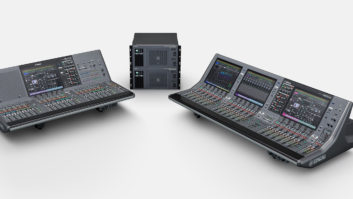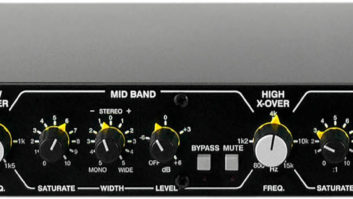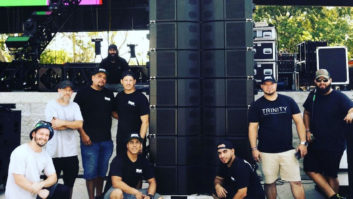Stamford, CT—Brian Setzer may be best known as a Stray Cat, but the man’s more like a chameleon. Over the course of a two-hour show with the Brian Setzer Orchestra, he takes equal turns as a genteel big-band leader, Fifties crooner, virtuoso guitar player and rockabilly wildman.
You can add unabashed sentimentalist to the list, too, as proven yearly by the BSO’s annual Christmas Rocks tour, which mixes revved-up holiday standards like “Angels We Have Heard On High” and “Here Comes Santa Claus” with classics from Setzer’s own catalog, ranging from “Stray Cat Strut” and “Rock This Town” from his Stray Cats days to the BSO’s hit remake of Louis Prima’s “Jump Jive An’ Wail.”

The band just wrapped up its 12th annual Christmas tour, and in recent years, the 19-piece orchestra has been carrying production from Sound Image (Escondido, CA) with longtime engineers Gary Hartung and Marcus Douglas manning the FOH and monitor desks, respectively. By necessity because of the holiday season, the tour heads out in mid-November and hits the road hard—between November 14 and December 29 last year, the BSO played 31 shows, in addition to making appearances on Conan O’Brien’s late-night show and a Sirius Radio concert in New York City’s Times Square.
With such a hectic schedule, consistency is key, particularly since the tour uses local PA at each stop. Hartung mixes every show on a Midas Pro9 desk, and noted that while he has some outboard units, “I haven’t changed my effect parameters in two years. I have standard things I like, like a [Lexicon] PCM70 for the snare plate; the 480 Hall program on a [TC Electronic] M5000 for my main vocal reverb; and then there’s a [Roland] SDE-3000 delay for Brian’s vocal—I do that 140-150 ms, no-repeat delay to get that old Elvis, rockabilly kind of slap. On the Christmas stuff, I lay off that a bit, but on the rockabilly and the Stray Cat songs, I put in more delay.”
Ultimately, Hartung goes light on the effects, in part to provide a mix that’s present and in the moment. “I don’t go about recreating the album, because in a live environment, the energy is different,” he said. “That’s why I like mixing live on the fly—because you can do scenes and snapshots, but the reality is that different nights have a different energy, and you have to react to that.

“Brian’s on top of the mix because it’s his show and naturally he should be in a certain place; then it’s just finding that balance because they’re all playing off of each other. There are parts like on ‘Rock This Town’ and ‘Jump Jive an’ Wail’ where the trumpets and the saxes go back and forth, and I’m literally pushing faders, alternating—trumpets up, saxes up, trumpets up, saxes up. So it’s a pretty dynamic mix, but the rhythm section stays where it is the whole time and I just gas the horns when necessary.”
Over in monitorworld, Douglas provides 25 mixes variously through in-ears and wedges around the stage, mixing on a Yamaha CL5 console. “We have 24 channels of wireless out here, and setting that up can be the hardest part of the day,” he said. “Some days I’m fighting to find room and other days, it’s easy. It’s all Shure PSM 1000s for the in-ears with JH Audio ear buds, and then we use the Shure UR4Ds for the mics and the horns.”
Setzer eschews in-ears, opting for four wedges, with two in front providing vocals, and both outer wedges and Vue Audiotechnik side-fills serving up some guitar, piano and rhythm section. In-ear mixes go to one of the background singers; Tim Messina, musical director and fourth sax; Kevin McKendree, a newly added piano player; and the drummer, who alternates with a wedge. “The saxes all share a PreSonus [HP4] headphone amp and they share a mix of just themselves and little of the others. It’s the same with the trombones—but the trumpets don’t want anything. I tried a hardwire mix on one of the trumpet players the other night and he had a hard time, getting tangled up, so they go without.”
Key to the Brian Setzer Orchestra’s sound, of course, is Brian Setzer—specifically his guitar. Capturing every lightning-quick run up and down the fretboard are a variety of mics. “On Brian’s amp, I use a Shure KSM32 and an SM7B, the big broadcast vocal mic,” said Hartung. “I like the combination of a condenser and a dynamic, because it gives me a different texture, flavor. The reality is that even though Brian’s tone is loud, it’s good tone that’s very consistent. There’s no curveballs ever thrown when it comes to that, so I use a condenser and a dynamic, and they blend well.”

All vocals are captured with Shure SM58s. while the drums are heard via a selection of Shure and Audix mics. “On the kick, there’s an SM91—not a Beta because I like the SM91/D6 combination; you can’t go wrong with it,” said Hartung. “I always use the Audix D2 on snare; it wasn’t designed for that, but I love it. Then there’s D2s on rack toms, D4s on floor toms, AKG 414s on overheads, Sennheiser MD-441 on snare bottom, and KSM137s on high hat.”
The horn players all use wireless mic setups with Shure WB98H/C capsules, while the glockenspiel is heard via a Sony ECM 54P “Nobody uses it, but it’s just a gem of a mic,” said Hartung. “We have all Radial JDIs and J48s.There’s Shure VP88s at FOH, just to capture the stereo mix of the audience because we record every night.”
While the tour’s pace can be tough—not to mention the timing, being that it’s across the holidays, taking everyone far from home—both Hartung and Douglas readily admit the spirit of the production makes it worthwhile. “It’s such good people out here,” said Douglas. “The crew is great, same with the band, and it goes all the way to the top to Brian. We enjoy doing it—and it’s a great show. I get the chills every night just watching it, being a part of it.”
Sound Image
Sound-image.com
Shure
Shure.com
Vue Audiotechnik
Vueaudio.com







